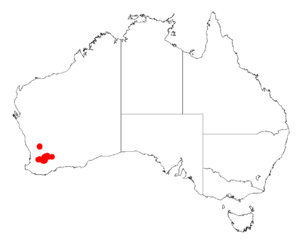Acacia deflexa facts for kids
Quick facts for kids Acacia deflexa |
|
|---|---|
| Conservation status | |
| Scientific classification | |
| Genus: |
Acacia
|
| Species: |
deflexa
|
 |
|
| Occurrence data from AVH | |
Acacia deflexa is a type of shrub. It belongs to the Acacia family, also known as wattles. This plant is special because it grows naturally only in a small part of southwestern Australia. This means it is an endemic species.
What it Looks Like
This shrub often grows in a sprawling way. It usually reaches a height of about 0.4 to 2 meters (1.3 to 6.5 feet). Its small branches are covered in thick hairs. Like most Acacia plants, it has phyllodes instead of true leaves. Phyllodes are flattened leaf stems that act like leaves.
The phyllodes of Acacia deflexa are thick and feel like leather. They point downwards or stick out sideways. They can be oval, broadly oval, or narrow and long. They are usually straight or slightly curved. These phyllodes are about 6 to 18 millimeters (0.24 to 0.71 inches) long. They are also 2 to 5 millimeters (0.08 to 0.20 inches) wide. Each phyllode has three clear, raised lines, which are like veins. The plant blooms from August to September. During this time, it produces bright yellow flowers.
Where it Lives
Acacia deflexa is found naturally in the Wheatbelt region of Western Australia. It often grows on flat areas. You can find it in gravelly sandy loam and sandy soils. It especially likes areas with laterite, which is a type of reddish soil.
The plant's home range stretches from places like Bendering and Ardath in the north. It goes down to areas around Cuballing and Harrismith in the south. It grows as part of low scrub and heathland plant communities.


